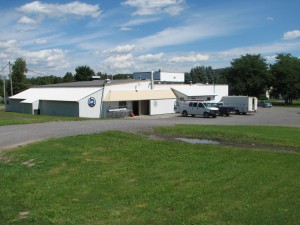A step away from politics to…meat!
 While you’re all digesting your politics, here’s an interesting note for local farmers and for meat-eating locavores.
While you’re all digesting your politics, here’s an interesting note for local farmers and for meat-eating locavores.
Over the summer I reported on the shortage of slaughterhouses (and the knifemen who work in them) in northern New York.
It appears the market is starting to make a correction. On the heels of a new state-of-the-art slaughterhouse opening in Washington county, another has opened in southern Oneida county.
New York Custom Processing, LLC, claims to be the biggest USDA-inspected, custom livestock processing facility in New York state. According to the press release from Cornell Cooperative Extension:
The facility offers full-service processing and custom packaging of all livestock. To insure food safety, it has a high-powered carcass steam-pasteurization, chill coolers, and vacuum packing systems.
The facility offers a state-of-the-art computerized tracking system for carcasses and finished meat cuts. Customers will be able to track their products with a complete breakdown of cuts and weights.
Why does this all matter? Because farmers wanting to raise some beef or pork can’t sell their cuts retail or at farmers markets unless it’s processed at a USDA-inspected facility.
With dairy farmers desperately try to claw their way out of last year’s milk price crisis, making some money by raising some meat doesn’t hurt.








Sorry, but you so soon forget the earth is overheating, and it’s the cow’s fault.
The American Farm Bureau Federation said, based on federal agriculture department figures, it would require farms or ranches with more than 25 dairy cows, 50 beef cattle or 200 hogs to pay an annual fee of about $175 for each dairy cow, $87.50 per head of beef cattle and $20 for each hog.
The executive vice president of the Wyoming Farm Bureau Federation, Ken Hamilton, estimated the fee would cost owners of a modest-sized cattle ranch $30,000 to $40,000 a year.
[cbsnews.com]
I guess the assumption is, that after paying these taxes, the earth will again be cool.
Tri-Town Packaging just put an addition on their building.
That’s the kind of below the radar small business we need. Nothing flashy and sexy, just good old basic services and enterprises.
Good on you guys and best of luck!
Well, there goes the neighborhood! Everyone knows that when a slaughter facility moves in the place gets trashed with stench and crime. No decent person (even if they eat animals) wants this kind of business around. BTW – It’s such a waste of resources — fattening these animals while the feed, land, water, refridgeration, etc. could go to producing and supplying REAL “food”. Now THAT’s sustainable.
In response to blaming the cow, I recommend reading a short publication by Joann Grohman, about just that topic. http://www.mogfa.org/Publications/MaineOrganicFarmerGardener/Summer2010/Cows/tabid/1614/Default.aspx.
Well Bea, maybe you could come to my farm and tell me just what REAL “food” you can raise on some of my pasture. And then tell me how that will provide jobs or economic well being to anyone besides me and the seed/fertilizer salesman, because all I’ll be doing is wasting seed and fertilizer trying to grow wheat or oats or beans on rocky/wooded pasture.
Man is an omnivore. Sustainable agriculture requires animals. But you go right on believing what you want and insulting anyone who thinks differently.
BTW- please provide any actual proof that packing houses breed crime, stench, etc. Good luck with that.
Thank you for the encouraging information. I buy all my meat from local sources. The farmers have expressed their frustration at having to send their animals to Vermont for a USDA approved butcher. New York state has many opportunities to build upon to improve our local food economy.
Turd, thanks for the reminder on the TriTown addition. (It’s the subject of one of the stories I linked to in this post.) I saw it the other day…looks great.
As for the meat-eating debate, I’ll stay out of that, except to say there are a lot of “local farm movement” vegetable farmers in the North Country who are raising beef, pork, and lamb to supplement their income, especially in the winter. They need to have someplace to slaughter their animals.
There is a group in St. Lawrence County that’s trying to gather funding for a mobile slaughterhouse. One of the reasons they give is to make the slaughter as humane as possible, by keeping the animals on the farm where they were raised, rather than stuffing them into a truck and driving them across the region, which is now the only option.
Thank you Washington for helping farmers with getting more local slaughter houses! We screamed about this during the Bush years, but they sat on their fannies and capitulated to big business! Our economy will turn with the support of local businesses and with stopping the excess support of huge companies that has gone on for years.